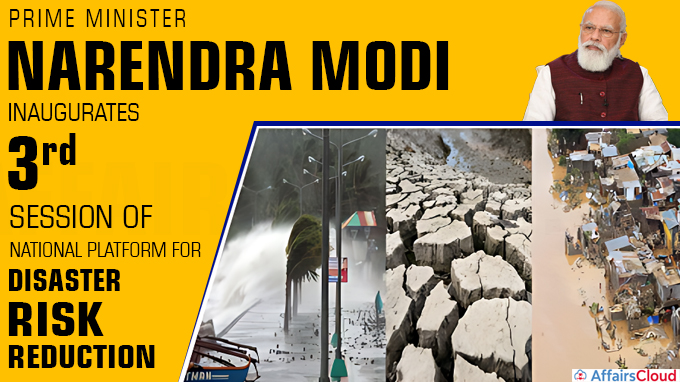 The 3rd session of the National Platform for Disaster Risk Reduction (NPDRR), with the overarching theme of “Building Local Resilience in a Changing Climate,” was inaugurated by Prime Minister (PM) Narendra Modi on March 10, 2023, in New Delhi, Delhi.
The 3rd session of the National Platform for Disaster Risk Reduction (NPDRR), with the overarching theme of “Building Local Resilience in a Changing Climate,” was inaugurated by Prime Minister (PM) Narendra Modi on March 10, 2023, in New Delhi, Delhi.
- The main theme of the 3rd session of NPDRR is aligned with the PM’s 10-Point Agenda on Disaster Risk Reduction (DRR): ‘Build on local capacity and initiative to enhance disaster risk reduction’, particularly in the context of a fast-changing disaster risk scenario as a result of climate change.
NPDRR is a multi-stakeholder platform established by the Government of India (GoI) to promote dialogue through sharing experiences, views, and ideas, conducting action-oriented research, and exploring opportunities in the field of DRR.
Highlights of the event:
i.During the event, the PM honoured the winners of the Subhash Chandra Bose Aapda Prabandhan Puraskar 2023: The Odisha State Disaster Management Authority (OSDMA) and the Lunglei Fire Station in Mizoram.
ii.The PM also inaugurated the exhibition, which featured innovative disaster risk reduction ideas, initiatives, tools, and technologies.
iii.The ministerial session on “Strengthening of the Disaster Management System in the States” was presided over by Union Jal Shakti Minister Gajendra Singh Shekhawat after the inaugural session.
iv.Also, the thematic sessions “Building Local Resilience for Disaster Risk Reduction” and “Climate Change Adaptation & Disaster Risk Reduction: Nature-Based Solutions” were held.
v.Union Home Minister Amit Shah and Minister of State (MoS) for Home Affairs Nityanand Rai attended the event, which featured four plenary sessions, one ministerial session, and eight thematic sessions.
Related Facts:
i.Bhungas are traditional houses, a specific kind of round mud hut associated with the Kutch desert region of Gujarat, which largely survived the earthquake.
ii.Gujarat was the first state to enact the State Disaster Management Act in 2001.
- The then-Union Government enacted the Disaster Management Act, 2005 (DMA, 2005) on the basis of this act, resulting in the establishment of the National Disaster Management Authority (NDMA).
National Disaster Management Authority (NDMA)
i.The NDMA, which is headed by the PM of India, is the apex body for disaster management in India.
- The DMA, 2005 requires the establishment of the NDMA as well as the creation of an enabling environment for institutional processes at the state and district levels.
- The NDMA is responsible for developing disaster management policies, plans, and guidelines.
ii.India seeks to establish a culture that emphasizes preparedness, mitigation, prevention, and response.
iii.In February 2021, based on the recommendations of the 15th Finance Commission, the Union government allocated Rs 32,031 crore to the State Disaster Mitigation Fund (SDMF) and Rs 13,693 crore to the National Disaster Mitigation Fund (NDMF) for 2021-22 to 2025-26.
Significant Initiatives
Amit Shah stated about the good functioning of mobile apps – Mausam, Meghdoot, Damini and crowd sourcing.
i.The India Meteorological Department (IMD) launched 3 mobile applications: MAUSAM, Meghdoot, and Damini in September 2020 to improve the dissemination of weather forecasts and warning services using the most recent tools and technologies.
- The MAUSAM Mobile App of the IMD, Ministry of Earth Sciences (MoES), intends to enable seamless and user-friendly access to weather products available on https://mausam.imd.gov.in/.
- The Meghdoot mobile app will provide farmers with high-resolution weather forecast-based agro-advisories in the vernacular.
- The Damini Lightning Alert app provides users with lightning warnings based on their location.
ii.Under PM Narendra Modi’s direction, 8 guidelines have been developed that cover the following topics: the cold wave, protection from earthquakes, insulation of roofs for cooling, glacier lake outburst floods, heatwaves, risk reduction during landslides, disability-inclusive disaster risk reduction, and making permanent shelters for families affected by disasters.
Coalition for Disaster Resilient Infrastructure (CDRI)
i.The Coalition for Disaster Resilient Infrastructure (CDRI) was formed in 2019 under the leadership of the GoI and with the cooperation of the United Nations Office for Disaster Risk Reduction (UNDRR).
ii.It is an international cooperation with many different stakeholders, including national governments, United Nations (UN) agencies and programmes, multilateral development banks, the private sector, and academic institutions.
iii.CDRI seeks to increase the resilience of infrastructure systems to climate and disaster hazards, assuring sustainable development.
- The CDRI now has more than 100 member countries across the globe.
PM Modi Dedicates World’s Longest Railway Platform in Hubballi Station, Karnataka
On March 12, 2023, PM Narendra Modi dedicated to the nation the world’s longest railway platform at “Shree Siddharoodha Swamiji Hubballi Station” in Hubballi-Dharwad, Karnataka, which was recently acknowledged by the Guinness Book of World Records.
- The railway platform is 1507 metres long and built at a cost of around Rs 20 crore.
Other key development projects in Hubballi-Dharwad, Karnataka
The PM also dedicated and laid the foundation for several significant development projects in Hubballi-Dharwad, Karnataka, such as:
i.Dedicated to the nation, the Indian Institute of Technology (IIT) Dharwad, whose foundation stone was also laid by the PM in February 2019.
ii.The electrification of the Hosapete-Hubballi-Tinaighat stretch, at a cost of Rs. 530 crore, as well as the upgradation of the Hosapete station, to improve connectivity in the region.
- The redeveloped Hosapete station was designed to resemble the Hampi monuments of Karnataka.
iii.Various Hubballi-Dharwad smart city projects, with a total estimated cost of Rs. 520 crores.
iv.Laid the foundation stone for the Jayadeva Hospital and Research Centre, which will be built at a cost of around Rs. 250 crores and is intended to provide tertiary cardiac care to the residents of the region.
v.Laid the foundation stone for the Dharwad Multi Village Water Supply System, which would be built at a cost of around Rs. 1,040 crores.
vi.Laid the foundation stone for the Tupparihalla Flood Damage Control Project, which will be built at a cost of Rs. 150 crore and seeks to mitigate flood damage through the construction of retaining walls and embankments.
Recent Related News:
i.The National Disaster Response Force (NDRF) Raising Day is annually observed across India on January 19 to commemorate the establishment of the NDRF, under the Ministry of Home Affairs. January 19, 2023 marks the observance of the 18th NDRF Raising Day. The 1st ever NDRF Raising Day was observed on 19th January 2006.
ii.The NDRF is a specialist force that is prepared to respond to various disasters, including man-made disasters (chemical spills and terrorist attacks) and natural disasters (floods, cyclones, and earthquakes).
About the National Disaster Response Force (NDRF):
Director General – Atul Karwal
Headquarters – New Delhi, Delhi
Motto – Sustained Disaster Response Service




